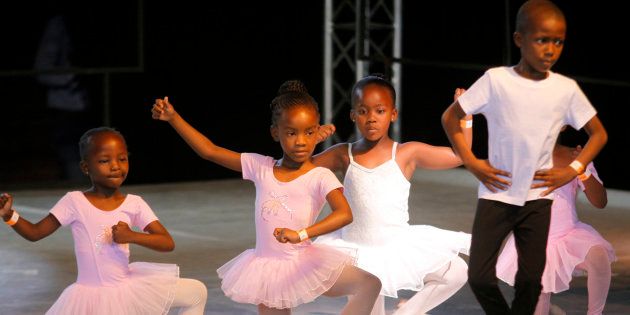
The 8-year-old in torn tights and a bright pink leotard, her gaze fixed firmly on the classroom wall, her legs determinedly finding the most perfect First Position she could manage without a mirror, ignored the cold Cape Town wind whipping through the classroom. A window banged, its fastening broken, the desks and motley selection of chairs piled around the edges of the room, but nothing existed except for her dreams and her intense focus.
It is that same dedication and discipline that Dance For All has brought to over 17,000 children in disadvantaged situations across the city and into the rural areas, and which has seen dramatic shifts in individuals, families, and the communities in which they've worked, for 25 years.
It's the same discipline and focus that carried the former principal dancer Philip Boyd, and his late wife, prima ballerina assoluta, Phyllis Spira, into the Western Cape townships in 1991 to teach, mentor and dedicate so much of their lives to this goal: that a child can see their future beyond the poverty, beyond the hunger, beyond the crime and gangs and violence that is so pervasive.
Giving up his career as principal dancer to form Dance For All, and with Spira teaching classes daily, the couple not only created a safe space for a healthy activity, but established a high, professional standard that has seen many of their students go on to illustrious international careers.
Going beyond the city into rural areas, the current Rural Outreach programme has enrolled more than 450 students from various farm schools who take daily classes in various forms of dance, bringing their student total to around 1,500.
In 2007, Dance For All took up residence in a two-story building in Athlone. Boyd describes it as a "crappy set up. This was the last building on the edge of the business district, with lots of bergies [homeless beggars] and addicts on the corner, peddling drugs. The train station is right there. We were broken into five times at gunpoint when we first moved in. But that has changed now, we don't feel threatened anymore."
"This is a lifeline that has to be understood, respected, and funding has to be sourced because it's given, and will continue to give, thousands of children so much more hope."
Boyd approached the local shop owners in a determined effort to 'buy-in' to the community, "to tell them who we were and what our contribution could be. And slowly, the community of Athlone started rebuilding the area. The station has been revamped, the streets cleared of bad elements. You can see it," Boyd continues. "It's wonderful to see how this space has changed the community. We are here, there are things happening. Having a home has been so important. It means a lot more money needs to be raised to continue the footprint in the community, but we're not temporary. We've put down roots and it makes all the difference to the people who live there."
Many of the students, and some of the teachers, have been with Dance For All since the beginning, and in some cases, their children are now students. "It's a lifeline for children and it's consistent. It's serious dance training and if a student has the ambition to go further, they can say, 'I've done this on my own, through my own commitment, not because of the hand out we've been given, but that we've actually worked for it'. They're good because they've had good training, not because they have received a handout."
"We've become an institution that has sustainability -– the financial sustainability is one of the hardest things and it's the thing that stresses me out to no end, with a financial shortfall of around R3 million annually –- but I started this and I have to keep it going because I cannot walk away from it.
The same steely determination I saw in the young girl's eyes in the Nyanga classroom crosses Boyd's face. "This is a lifeline that has to be understood, respected, and funding has to be sourced because it's given, and will continue to give, thousands of children so much more hope."
"These kids walk through the townships in their tights and their ballet shoes and they couldn't give a toss what anybody thinks. It's beautiful! I wish I could have been like that." –- Philip Boyd
